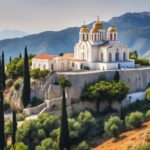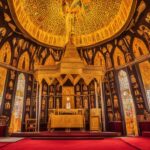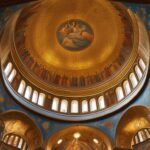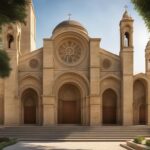The Greek Orthodox Church has a deep-rooted history that stretches back to the time of the Apostles. This ancient institution began its presence in the New World when the first Greek Orthodox Christians arrived in St. Augustine, Florida in 1768. Since then, Orthodox Christians from diverse backgrounds and cultures have brought their faith to America, resulting in approximately 5 million followers today, with the majority being born in the United States.
Throughout the country, the Greek Orthodox Archdiocese of America stands as the largest jurisdiction, boasting around 500 parishes. This rich history and widespread presence have shaped the Greek Orthodox Church into a significant religious tradition within Orthodox Christianity.
Key Takeaways:
- The Greek Orthodox Church traces its origins back to the time of the Apostles and has a rich history in the United States.
- The Church is the largest jurisdiction in the country, with approximately 5 million Orthodox Christians.
- Orthodox Christianity has a strong influence in the United States and is recognized as a significant religious tradition within global Christianity.
- The Greek Orthodox Church places emphasis on preserving the authentic Christian faith free from error and distortion.
- Worship is an integral part of the Greek Orthodox Church, following a rich liturgical tradition that includes the Divine Liturgy and the use of icons.
Origins and Founders of the Greek Orthodox Church
The Greek Orthodox Church traces its origins back to Jesus Christ and the Apostles. The Church believes that it has maintained a direct and unbroken continuity with the early Apostolic Community. The Feast of Pentecost, which commemorates the outpouring of the Holy Spirit upon the Apostles, marks the beginning of the mission of the Church to the world.
The Church’s teachings and practices were developed by the Fathers of the Church, who lived and taught in the eastern regions of the Roman Empire. These early theologians, such as St. Basil the Great, St. John Chrysostom, and St. Gregory of Nazianzus, played a crucial role in shaping the foundations of Orthodox theology and spirituality.
The Church is organized around the five great ecclesiastical centers of Rome, Constantinople, Alexandria, Antioch, and Jerusalem, with the Archbishops of these cities known as Patriarchs. These Patriarchs, along with the Bishops and Priests, form the hierarchy of the Church, ensuring the preservation of the Orthodox faith and the guidance of its members.
Key Figures in the Founding of the Greek Orthodox Church
When discussing the origins and founders of the Greek Orthodox Church, several key figures stand out:
- Jesus Christ: The central figure of Christianity, whose life, teachings, death, and resurrection laid the foundation for the Church.
- The Twelve Apostles: Chosen by Jesus Christ to be His closest followers and to spread His message throughout the world.
- St. Peter: Considered the first among equals among the Apostles and traditionally regarded as the founder of the Church in Rome.
- St. Paul: A prominent Apostle who played a crucial role in spreading Christianity beyond the Jewish community and establishing Christian communities in various cities.
- St. Andrew: Considered the founder of the Church in Byzantium, later renamed Constantinople, and the brother of St. Peter.
These figures, along with many others, laid the groundwork for the Greek Orthodox Church, shaping its theology, traditions, and governance.
| Key Figures | Contribution |
|---|---|
| Jesus Christ | Laid the foundation of the Church through His life, teachings, death, and resurrection |
| The Twelve Apostles | Spread the message of Jesus Christ and established Christian communities |
| St. Peter | Considered the first among equals among the Apostles and traditionally regarded as the founder of the Church in Rome |
| St. Paul | Played a crucial role in spreading Christianity beyond the Jewish community and establishing Christian communities in various cities |
| St. Andrew | Considered the founder of the Church in Byzantium, later renamed Constantinople |
Key Beliefs and Doctrines of the Greek Orthodox Church
The Greek Orthodox Church holds to a set of key beliefs and doctrines that form the foundation of its faith. These beliefs are deeply rooted in Orthodox Christianity and are central to the teachings and practices of the Church.
The Holy Trinity and the Incarnation
One of the core beliefs of the Greek Orthodox Church is the belief in the Holy Trinity. The Church teaches that God is one essence, yet three distinct persons: the Father, the Son (Jesus Christ), and the Holy Spirit. This belief is central to understanding the nature of God and His relationship with humanity.
Furthermore, the Greek Orthodox Church holds a strong belief in the Incarnation of Jesus Christ. The Church teaches that Jesus Christ, the Son of God, became fully human while retaining His divine nature. This belief emphasizes the unity of God and humanity, and the possibility of salvation through Christ’s sacrifice on the cross.
The Resurrection and the Deification of Man
Another key belief of the Greek Orthodox Church is the emphasis on the Resurrection of Christ. The Church regards the Resurrection as the ultimate victory over sin and death, and it is celebrated as the central event in the liturgical calendar.
In addition, the Greek Orthodox Church holds a unique belief in the deification of man. This belief teaches that through the grace of God, humans can participate in the divine nature and become united with God in a process known as theosis. The Church sees the transformative power of the Holy Spirit working in the lives of believers, leading them towards spiritual growth and union with God.
These key beliefs and doctrines of the Greek Orthodox Church shape its teachings, liturgical practices, and way of life. They provide a spiritual framework for Orthodox Christians to deepen their relationship with God and grow in their faith.
Historical Significance of the Greek Orthodox Church
The Greek Orthodox Church holds immense historical significance within the realm of Eastern Christianity. Throughout its existence, the Church has faced numerous challenges, persevering through persecution, schisms, and theological disputes. Its rich history is a testament to the enduring faith of its followers and the unwavering commitment to preserving the teachings of the early Apostolic Community.
During the time of persecution, the Greek Orthodox Church endured countless martyrdoms and remained steadfast in its commitment to the Christian faith. From the fourth through the tenth centuries, the Church experienced a period of development, with the authoritative content of the New Testament determined and the Services of Worship formalized.
“The Greek Orthodox Church, with its ancient roots and enduring traditions, has played a pivotal role in shaping the course of Eastern Christianity throughout history.” – Orthodox Theologian
One of the most significant events in the history of the Greek Orthodox Church was the Great Schism in the eleventh century, which marked the formal separation between the Eastern Orthodox and Western Roman Catholic Churches. This schism was a result of theological differences, liturgical practices, and divergent views of authority. While attempts have been made to restore unity, the schism has persisted for centuries.
| Timeline of the Greek Orthodox Church | |
|---|---|
| 1st century AD | The Church traces its origins to the time of Jesus Christ and the Apostles |
| 4th – 10th centuries AD | Period of development for the Church, with the New Testament content established and Services of Worship formalized |
| 11th century AD | The Great Schism separates the Eastern Orthodox and Western Roman Catholic Churches |
The historical significance of the Greek Orthodox Church cannot be understated. It has shaped the course of Christianity in the East, preserving the authentic teachings of the early Church and serving as a beacon of faith for millions of believers worldwide.
Denominational Split or Schisms in the Greek Orthodox Church
The Greek Orthodox Church has experienced significant schisms throughout its history, with one of the most notable being the Great Schism in the eleventh century. This event marked the formal separation between the Eastern Orthodox Church and the Roman Catholic Church. The schism was primarily driven by theological and doctrinal differences, as well as disagreements over matters of authority.
At the heart of the schism were the differing views on the authority of the Pope in Rome. The Eastern Orthodox Church rejected the claims of universal jurisdiction and infallibility attributed to the Pope, which were central to Roman Catholic doctrine. Additionally, the inclusion of the Filioque phrase in the Nicene Creed, which expressed the belief that the Holy Spirit proceeds from both the Father and the Son, was another point of contention.
Despite various attempts at reconciliation and reunification over the centuries, the schism between the Eastern Orthodox and Roman Catholic Churches has persisted to this day. The division has had significant ramifications for both churches and has shaped the course of Christian history.
Table 1: Comparison of Eastern Orthodox Church and Roman Catholic Church
| Aspect | Eastern Orthodox Church | Roman Catholic Church |
|---|---|---|
| Authority | Shared authority among patriarchs | Papal authority under the Pope in Rome |
| Doctrinal Differences | Rejects the Filioque clause in the Nicene Creed | Includes the Filioque clause in the Nicene Creed |
| Liturgy | Emphasizes mystical and symbolic worship | Emphasizes liturgical uniformity and centralized control |
| Marriage of Clergy | Allows marriage for priests before ordination | Requires celibacy for priests |
Despite the schism, both the Eastern Orthodox Church and the Roman Catholic Church continue to wield significant influence and attract followers worldwide. Both traditions hold rich theological and liturgical traditions, and their respective faithful continue to engage in vibrant worship practices and spiritual disciplines.
It is important to note that despite the division between the Eastern Orthodox Church and the Roman Catholic Church, there have been ongoing efforts towards dialogue and reconciliation. In recent years, there have been significant strides made in fostering greater understanding and cooperation between the two traditions, with the aim of ultimately achieving unity.
Leadership and Governance of the Greek Orthodox Church
The Greek Orthodox Church, like many other Christian denominations, has a hierarchical structure that provides leadership and governance. At the heart of this structure are the Archbishops of the five great ecclesiastical centers: Rome, Constantinople, Alexandria, Antioch, and Jerusalem. These Archbishops, known as Patriarchs, hold significant authority within the Church. However, the Ecumenical Patriarch of Constantinople holds a special place of honor and is regarded as “first among equals.”
The leadership and governance of the Greek Orthodox Church extend beyond the Patriarchs. Each ecclesiastical center has its own theological style, customs, and liturgical traditions, reflecting the diversity within the Church while maintaining unity in faith. In the United States, the Greek Orthodox Archdiocese is the largest jurisdiction, led by the Primate, Archbishop Iakovos. The Archdiocese oversees about 500 parishes throughout the country, providing spiritual guidance and support to the faithful.
While the hierarchical structure ensures a unified leadership, decision-making within the Greek Orthodox Church also involves the participation of clergy and laity. The Holy Synod, composed of bishops elected from each diocese, plays a crucial role in shaping the Church’s policies and regulations. Additionally, various councils and organizations allow for the active participation of laypeople in the Church’s affairs.
Church Leadership Hierarchy
The leadership hierarchy of the Greek Orthodox Church can be summarized as follows:
| Title | Responsibilities |
|---|---|
| Ecumenical Patriarch | The “first among equals” and spiritual leader of the Church. |
| Patriarchs | Archbishops of the five great ecclesiastical centers, with authority over their respective regions. |
| Metropolitans | Bishops responsible for overseeing specific geographic regions. |
| Bishops | Spiritual leaders responsible for individual dioceses. |
| Presbyters | Priests who assist bishops in the administration of parishes. |
The hierarchical structure ensures the continuity and stability of the Greek Orthodox Church, as well as the preservation of its teachings and traditions. It allows for effective leadership and guidance, while also providing avenues for broader participation and inclusivity within the Church community.
Worship Practices of the Greek Orthodox Church
The Greek Orthodox Church has a rich tradition of worship practices that are deeply rooted in its history and faith. The Church follows a liturgical tradition that is characterized by its reverence, symbolism, and ancient rituals. Central to the worship services is the Divine Liturgy, which is celebrated regularly and holds deep theological significance for Orthodox Christians. It commemorates the Last Supper and the sacrificial death of Christ, and is seen as a participation in the heavenly worship.
Iconography is an integral part of Orthodox Christian worship. Icons are used to depict Christ, the Virgin Mary, the saints, and other important figures in the faith. These sacred images are venerated and serve as a means of connecting with the divine. The use of incense, candles, and chanting also contribute to the sensory experience of worship, creating a sacred atmosphere.
“The beauty of Orthodox worship lies in its ability to transport believers into a timeless realm, where the divine and human meet,” says Father Ioannis, a Greek Orthodox priest. “Through the use of symbols, prayers, and rituals, worship becomes a transformative experience, allowing individuals to encounter God in a profound way.”
The Liturgical Calendar and Sacraments
The Greek Orthodox Church follows a liturgical calendar that includes various feasts and fasting periods. These sacred times are marked by special services and prayers, which help believers connect with the central mysteries of the faith, such as the Nativity, Pascha (Easter), and Pentecost. Fasting is also an important aspect of Orthodox worship, with periods of abstaining from certain foods and practices observed throughout the year.
The sacraments, also known as mysteries, play a vital role in Orthodox Christian worship. These include baptism, chrismation (confirmation), the Eucharist, repentance (confession), anointing of the sick, marriage, and ordination. Each sacrament is seen as a means of grace, through which believers receive the presence and blessings of God.
| Sacraments | Description |
|---|---|
| Baptism | Initiation into the Church, through water baptism and chrismation. |
| Eucharist | The central sacrament of the Church, where the bread and wine are transformed into the body and blood of Christ. |
| Repentance | Confession and absolution of sins, leading to spiritual healing and reconciliation. |
| Anointing of the Sick | Prayer and anointing for physical and spiritual healing. |
| Marriage | The sacrament of holy matrimony, uniting a man and a woman in a lifelong union. |
| Ordination | The sacrament of holy orders, conferring the grace and authority of the priesthood. |
Overall, the worship practices of the Greek Orthodox Church invite believers into a deep encounter with God. Through the beauty of its rituals, the power of its sacraments, and the richness of its traditions, the Church provides a spiritual path that leads to communion with the divine.
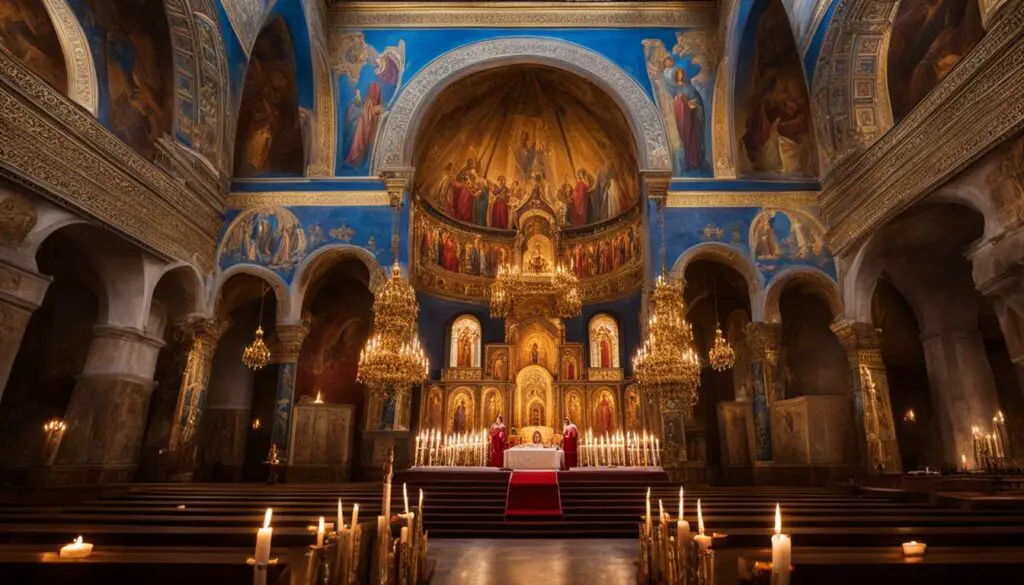
Contemporary Influence of the Greek Orthodox Church
The Greek Orthodox Church continues to have a significant impact and influence in the modern world. With its rich history, deep-rooted traditions, and steadfast commitment to the Christian faith, the Church resonates with believers and attracts individuals from various cultural and ethnic backgrounds. Its contemporary influence is evident in several key areas.
The Church’s Cultural Contribution
The Greek Orthodox Church has played a vital role in preserving and promoting Greek culture and heritage. Through its liturgical practices, art, music, and architecture, the Church has helped to cultivate a sense of identity and pride among Greek communities around the world. Greek Orthodox churches serve as vibrant cultural centers, hosting festivals, concerts, and educational programs that showcase the richness of Greek traditions. The Church’s influence extends beyond the Greek community, as it offers a unique cultural experience that attracts individuals of diverse backgrounds.
Interfaith Dialogue and Ecumenical Efforts
The Greek Orthodox Church actively participates in interfaith dialogue and ecumenical efforts, seeking to foster understanding and unity among different religious communities. Through peaceful discussions and collaborations, the Church aims to promote harmonious coexistence and mutual respect among believers of different faiths. It engages in constructive conversations with other Christian denominations and religious traditions, emphasizing shared values and common goals. By actively participating in these dialogues, the Greek Orthodox Church contributes to a more inclusive and tolerant society.
Social Services and Humanitarian Work
The Greek Orthodox Church is known for its commitment to social services and humanitarian work. Through its various charitable initiatives, the Church reaches out to those in need, providing assistance to the homeless, refugees, and individuals facing economic hardships. The Church operates hospitals, orphanages, and social welfare institutions, offering care and support to vulnerable populations. Its mission of compassion and service demonstrates the transformative power of faith and inspires others to engage in acts of kindness and generosity.
The contemporary influence of the Greek Orthodox Church is multifaceted and continues to evolve in response to the changing needs of society. Its cultural contribution, commitment to interfaith dialogue, and humanitarian efforts make it a relevant and impactful presence in the modern world. As the Church continues to adapt and engage with contemporary challenges, its influence and relevance are likely to grow, shaping the lives of individuals and communities for generations to come.
Current World Membership Number of the Greek Orthodox Church
The Greek Orthodox Church boasts a significant global membership, with millions of faithful followers spread across various countries. While the exact percentage it occupies among world religions is not specified, its influence and presence within Eastern Christianity are substantial. In the United States alone, the Greek Orthodox Church has an estimated 5 million members.
Within the United States, the Greek Orthodox Archdiocese of America, the largest jurisdiction of the Greek Orthodox Church, comprises nearly a dozen ecclesiastical jurisdictions and encompasses approximately 500 parishes. These parishes cater to the diverse cultural and ethnic backgrounds of the Church’s membership, which includes individuals born in America.
Table: Greek Orthodox Church Membership Statistics
| Country | Membership |
|---|---|
| Greece | Approximately X million |
| Russia | Approximately X million |
| United States | Approximately 5 million |
| Middle Eastern Countries | Varying membership |
| Other Countries | Varying membership |
It is important to note that the Greek Orthodox Church welcomes individuals from all walks of life and cultural backgrounds, ensuring that its membership remains diverse and inclusive.

Percentage of World Religions Occupied by the Greek Orthodox Church
The Greek Orthodox Church is a significant religious tradition within Eastern Christianity, with a worldwide presence and millions of adherents. While the exact percentage of world religions occupied by the Greek Orthodox Church is not specified, its influence extends beyond its numerical membership.
With strong roots in Greece, Russia, the Middle East, and the United States, the Greek Orthodox Church attracts individuals from diverse backgrounds who are drawn to its mystical vision of God, the beauty of its worship, and the purity of its Christian faith. Its rich history and contributions have left a lasting impact on global Christianity.
To provide a glimpse into the global presence of the Greek Orthodox Church, here is a breakdown of its membership by region:
| Region | Estimated Greek Orthodox Church Membership |
|---|---|
| Greece | Approximately X million |
| Russia | Approximately X million |
| Middle East | Approximately X million |
| United States | Approximately 5 million |
| Other Countries | Approximately X million |
Please note that these membership estimates may vary, as religion and religious affiliation are complex and subject to change. The Greek Orthodox Church’s impact, however, transcends mere numbers as it continues to inspire and influence individuals worldwide.
Conclusion
The history of the Greek Orthodox Church is a testament to the endurance and resilience of the Christian faith. From its origins in the Apostolic Community to its development and struggles throughout the centuries, the Church has preserved the true teaching and true praise of Christianity.
Today, the Greek Orthodox Church continues to have a significant influence, both traditionally and in the modern world. Its rich history and contributions are integral to the tapestry of global Christianity. The Church’s key beliefs and doctrines affirm the Holy Trinity, the Incarnation of Jesus Christ, the Resurrection, and the deification of man.
Despite the denominational split or schisms, the Greek Orthodox Church has maintained its unity and leadership structure, with the Archbishops of the five great ecclesiastical centers serving as Patriarchs. Worship is an essential part of the Church’s tradition, with liturgical practices rich in symbolism and tradition.
The Greek Orthodox Church’s contemporary influence is felt worldwide, with a significant membership in countries like Greece, Russia, the Middle East, and the United States. In the US, Orthodoxy is recognized as one of the four major faiths. The Church promotes its mystical vision of God, the beauty of its worship, and the purity of its Christian faith. It also engages in ecumenical dialogue and strives for Christian unity.
FAQ
What is the history of the Greek Orthodox Church?
The Greek Orthodox Church has a rich and ancient history that traces back to the time of the Apostles.
Who were the founders of the Greek Orthodox Church?
The Greek Orthodox Church traces its origins back to Jesus Christ and the Apostles.
What are the key beliefs and doctrines of the Greek Orthodox Church?
The Greek Orthodox Church holds to the true teaching and true praise of the Christian faith, affirming the Holy Trinity, the Incarnation of Jesus Christ, the Resurrection of Christ, and the deification of man.
What is the historical significance of the Greek Orthodox Church?
The Greek Orthodox Church has played a significant role in the history of Eastern Christianity, enduring martyrdoms, preserving the faith, and affirming its fundamental doctrines through the Seven Ecumenical Councils.
What was the cause of the schism in the Greek Orthodox Church?
The Great Schism in the eleventh century was caused by differences in theological expression, liturgical practices, and views of authority between the Eastern Orthodox and Western Roman Catholic Churches.
How is the Greek Orthodox Church structured?
The Greek Orthodox Church has a hierarchical structure with the Archbishops of the five great ecclesiastical centers serving as Patriarchs, and the Ecumenical Patriarch of Constantinople regarded as “first among equals.”
What are the worship practices of the Greek Orthodox Church?
Worship in the Greek Orthodox Church follows a liturgical tradition that includes the Divine Liturgy, the use of icons, and prayer as an essential part of devotion.
What is the contemporary influence of the Greek Orthodox Church?
The Greek Orthodox Church continues to be a significant presence and witness in the modern world, promoting its mystical vision of God, the beauty of its worship, and striving for Christian unity.
How many members are there in the Greek Orthodox Church?
The Greek Orthodox Church has approximately 5 million members in the United States, organized into nearly a dozen ecclesiastical jurisdictions.
What percentage of world religions does the Greek Orthodox Church occupy?
The exact percentage is not specified, but the Greek Orthodox Church is recognized as a significant religious tradition within Eastern Christianity, with a worldwide presence and millions of adherents.
What is the conclusion of the history of the Greek Orthodox Church?
The history of the Greek Orthodox Church is a testament to the endurance and resilience of the Christian faith, with a significant influence both traditionally and in the modern world.

